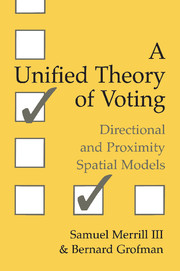Book contents
- Frontmatter
- Contents
- List of Tables and Figures
- Acknowledgments
- 1 Introduction
- Part I Models of Voter Behavior
- Part II Models of Party or Candidate Behavior and Strategy
- 8 Equilibrium Strategies for Two-Candidate Directional Spatial Models
- 9 Long-term Dynamics of Voter Choice and Party Strategy
- 10 Strategy and Equilibria in Multicandidate Elections
- 11 Strategy under Alternative Multicandidate Voting Procedures
- Postscript
- Appendices
- Glossary of Symbols
- References
- Index
8 - Equilibrium Strategies for Two-Candidate Directional Spatial Models
Published online by Cambridge University Press: 04 December 2009
- Frontmatter
- Contents
- List of Tables and Figures
- Acknowledgments
- 1 Introduction
- Part I Models of Voter Behavior
- Part II Models of Party or Candidate Behavior and Strategy
- 8 Equilibrium Strategies for Two-Candidate Directional Spatial Models
- 9 Long-term Dynamics of Voter Choice and Party Strategy
- 10 Strategy and Equilibria in Multicandidate Elections
- 11 Strategy under Alternative Multicandidate Voting Procedures
- Postscript
- Appendices
- Glossary of Symbols
- References
- Index
Summary
Things fall apart; the center cannot hold.
William Butler Yeats, “The Second Coming”Stable Strategies
In Part I of this book, we focused on the effects of issues on the behavior of voters. Much of our motivation for doing so rests on the implications of this behavior on candidate strategy. What do our conclusions about models of voter choice say about whether candidates and parties would benefit from choosing identical ideological positions as opposed to divergent ones? We have seen that the RM model is more likely to predict divergent strategies than the proximity model; mixed models and the Grofman discounting model make intermediate predictions.
A more fundamental question is: Are the strategies taken jointly by two or more candidates or parties stable, or does one party always have an incentive to defect? Otherwise put, does a set of stable strategies exist? Does the existence of stable strategies depend on the location of the neutral or status quo point, on the number of parties, on the dimension of the spatial model, or on the relative proportion of issue and non-issue voting?
In this chapter we investigate stable strategies for each of two candidates in a single two-candidate contest, i.e., choices of policy positions from which neither candidate alone would have an incentive to deviate. Such strategies constitute a Nash equilibrium. In Chapter 9, we extend the idea of stability from a single election to a sequence of elections between two parties, developing a dynamic equilibrium that is implied by the discounting model, and, by extension, a mixed RM-proximity model.
- Type
- Chapter
- Information
- A Unified Theory of VotingDirectional and Proximity Spatial Models, pp. 109 - 127Publisher: Cambridge University PressPrint publication year: 1999



